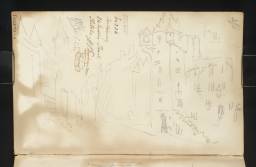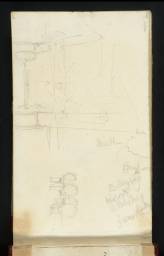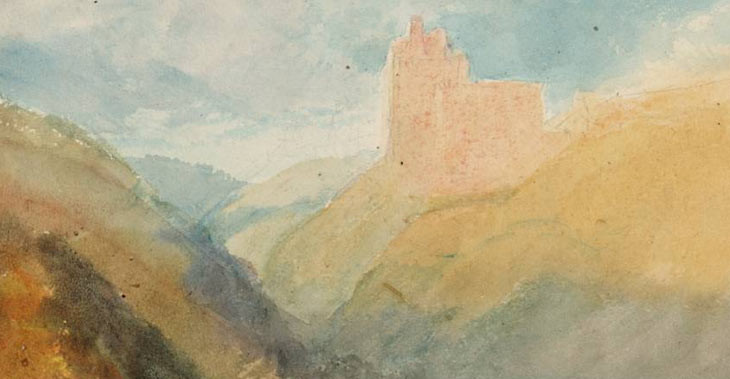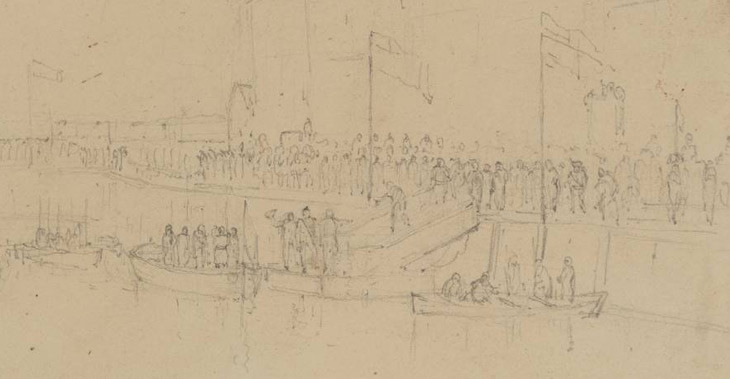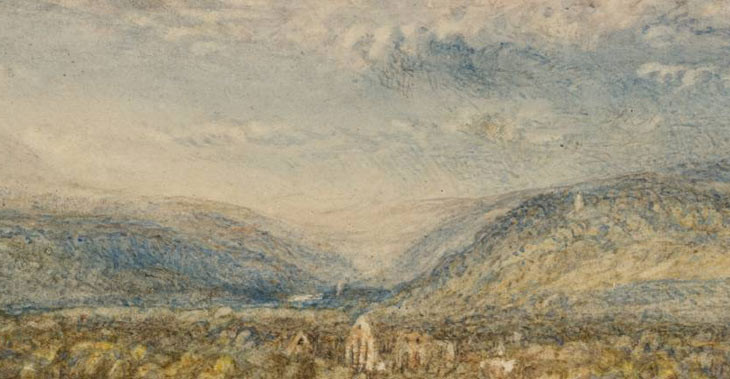Tour of Scotland, 1834 for Scott’s Prose Works; sketchbooks and a watercolour c.1834–5

From the entry
In September 1834 Turner made his sixth and final journey to Scotland. This was a visit of about three weeks that started and ended in Edinburgh, and involved two extensive tours: the first, lasting ten days, took the artist to Lanarkshire, Glasgow, Stirling, the Trossachs, Kinross-shire and Perthshire; the second, lasting just two days, took the artist to Peebles, Innerleithen, St Mary’s Loch, Selkirk and Melrose. As in 1818, 1822 and 1831 the journey was made in connection to Sir Walter Scott, though the author had now died. Turner’s business relationship with Scott’s publisher Robert Cadell, however, continued with three new publishing ventures. The formula had been established in 1831, when Turner made an extensive six-week tour of Scotland to sketch subjects to be worked up into watercolours and engraved as frontispiece and vignette illustrations to each volume of Scott’s collected Poetical Works; see Tour of Scotland for Scott’s Poetical Works 1831 Tour ...
Edinburgh Castle: March of the Highlanders circa 1834–5
N04953
Bequeathed by R.H. Williamson 1938
N04953
Bequeathed by R.H. Williamson 1938
References
In September 1834 Turner made his sixth and final journey to Scotland. This was a visit of about three weeks that started and ended in Edinburgh, and involved two extensive tours: the first, lasting ten days, took the artist to Lanarkshire, Glasgow, Stirling, the Trossachs, Kinross-shire and Perthshire; the second, lasting just two days, took the artist to Peebles, Innerleithen, St Mary’s Loch, Selkirk and Melrose.
As in 1818, 1822 and 1831 the journey was made in connection to Sir Walter Scott, though the author had now died. Turner’s business relationship with Scott’s publisher Robert Cadell, however, continued with three new publishing ventures. The formula had been established in 1831, when Turner made an extensive six-week tour of Scotland to sketch subjects to be worked up into watercolours and engraved as frontispiece and vignette illustrations to each volume of Scott’s collected Poetical Works; see Tour of Scotland for Scott’s Poetical Works 1831 Tour Introduction. By May 1834, while Turner was still preparing designs for the Poetry, Cadell approached him with offers of work on three new projects relating to Walter Scott.
The first project was a collected edition of Scott’s Prose Works. As the title suggests, the project was the logical follow-up to the Poetical Works, and may have been conceived around the same time.1 Eight Prose Works subjects had already been sketched by Turner during his 1831 Scottish tour, suggesting that he had been working on this project since that date; see the 1831 Tour Introduction. Further sketches, for the Life of Napoleon volumes of the Prose Works, were made by Turner in France in 1832.2 Other subjects would require a return to Scotland, or could be based on the work of other artists.
In 1833 Cadell began making plans for a new illustrated edition of the Waverley Novels, the collective title for the novels by the originally anonymous ‘author of Waverley’, sometimes used more generally to describe all of Scott’s novels. Despite having recently published the ‘Magnum’ edition of the novels (1829–33), Cadell, who had succeeded in purchasing half of the copyrights to each novel in 1831, hoped to bring out a new edition to maximise his profits from the works. Discovering in 1833 that Turner had been approached by Edward Finden to illustrate Scott’s poetry for a picture album, Cadell advanced his plans for the Waverley Novels, offering Turner in February 1833 a large commission of illustrations as a rival offer to Finden’s, which the artist accepted.3
Following Scott’s death on 21 September 1832, Cadell negotiated the purchase of the copyrights for all of Scott’s Prose Works and the proposed biography of Scott by his son-in-law John Gibson Lockhart.4 Discussion between Cadell and Lockhart in 1833 resulted in a plan for the Life to be published in a format uniform with the volumes of the Poetical Works and Prose Works, and again with illustrations by Turner.5
The decision to commission Turner to illustrate the Prose Works, Waverley Novels, and Life of Sir Walter Scott had therefore been taken in 1833 if not before. In early May 1834 Turner had meetings in London with Cadell and Lockhart to discuss the projects, after which the publisher noted in his diary: ‘I think we shall succeed in getting the old boy to come north [at] the end of the season.’6
Turner’s time in Scotland can be partially reconstructed thanks to Robert Cadell’s diary, which accounts for the days that the artist spent in Edinburgh between 15 September and 4 October 1834. The sites that the artist and publisher visited together can be matched to sketches in the Stirling and Edinburgh sketchbook and the Edinburgh sketchbook.7 There is no mention of Turner in Cadell’s diary between 19 and 29 September, or on the 2 and 3 October, though both gaps are preceded by entries with clues that suggest excursions. On 18 September Cadell states that Turner left for Lanark, and on 1 October that he and the artist planned the latter’s ‘proceedings tomorrow till Saturday’.8 Of this first excursion, Gerald Finley writes only that ‘we have, as yet, no documentation for this tour’,9 though for the second he was able to suggest a trip to ‘Selkirk [...] St Mary’s Loch and Innerleithen’.10
Research by David Wallace-Hadrill and Janet Carolan has helped to fill in some of the gaps. The two authors made numerous identifications of sketches and suggested a tour that they believed to have taken place in 1831.11 Subsequent unpublished research by Wallace-Hadrill has revealed that some of those sketches in fact belong to 1834,12 and his suggested itinerary for Turner’s 1834 tour, developed in an unpublished manuscript,13 although substantially revised by the present author, has identified some of the routes between the sketched locations. The full itinerary of these excursions has now been established as described below.
Turner left London for Scotland at the end of August or the beginning of September, travelling via Manchester, where Robert Cadell had sent him a letter to collect on 30 August.14 He arrived in Edinburgh on 14 or 15 September and met Cadell at his office in St Andrews Square on the 15th. The artist and publisher met again on the 16th, when they discussed the designs for the various projects, and on the 17th, when they planned the journey that Turner was to embark on the following day.15
On the morning of the 18th Cadell was out in his garden at Hailes on the south-western outskirts of Edinburgh, waiting for the Lanark coach upon which Turner was travelling. He had hoped to greet the artist, but, on seeing that he was asleep, decided not to disturb him.16 Gerald Finley has assumed that Turner ‘returned to Edinburgh that evening to join the Lockharts at dinner’, having read in Lockhart’s diary: ‘Mr Turner RA comes to dinner.’17 Finley, however, missed the significance of the previous day’s diary entry – ‘start for Miltonlockhart’ – and the note at the head of the entry on the 18th: ‘Milton Lockhart’.18 This was the name of the Lockhart family home near Rosebank on the banks of the River Clyde in Lanarkshire, then in the possession of John Gibson’s elder half-brother William.19 Therefore Turner stayed in Lanark that night, and did not return to Edinburgh before continuing his tour. This misunderstanding led Finley to believe that Lockhart and Turner visited Craigmillar Castle near Edinburgh on 19 September, when they in fact went to Craignethan, a ruin just two miles south of Milton Lockhart. Turner therefore began a ten-day tour of Scotland in Lanarkshire, where he spent two days.
Turner arrived in the town of Lanark on 18 September, and headed south to the Falls of the Clyde near the industrial town of New Lanark, where he made his first sketch in the Stirling and Edinburgh sketchbook as a possible illustration to Scott’s novel Old Mortality, 1816 (see Tate D26260; Turner Bequest CCLXIX 1a). At this stage it is possible to reconstruct his movements by directly following the sketchbook order. He visited Bonnington Linn and Corra Linn, sketching the two waterfalls, the gorge and Corra Castle, before heading to Milton Lockhart for dinner. The next day Turner was taken to Craignethan Castle by Lockhart (Tate D26286; Turner Bequest CCLXIX 14a),20 which is generally associated with Tillietudlem Castle in Old Mortality, 1816.
Lockhart does not mention going anywhere else with Turner, so he perhaps left him to go to the village of Douglas alone, where the artist sketched the ruin of Old Douglas Castle and the new mansion that stood nearby (Tate D26300; Turner Bequest CCLXIX 21a), before drawing the interior and exterior of St Bride’s Chapel (Tate D26305; Turner Bequest CCLXIX 24). These sites feature as locations in Scott’s novel Castle Dangerous, 1831. From Douglas Turner headed north to the town of Bothwell to draw the Castle and Bridge (Tate D26309; Turner Bequest CCLXIX 26). The Battle of Bothwell Bridge (1679) is a major incident in Old Mortality, so these two sites were probably considered as illustrations to that volume of the Waverley Novels.
The Bothwell sketches are the last of a neat sequence of sketched subjects in the Stirling and Edinburgh sketchbook. After this it is no longer possible to plot Turner’s route by following the sketchbook order so directly. The general order of sketches still follows Turner’s route, but subjects begin to appear out of place as Turner became less fastidious about using his sketchbook in order. He was soon to start sketching in the Loch Ard sketchbook (the correct order of which is unknown), which he used alongside Stirling and Edinburgh for the next week. The next part of his tour is reconstructed from the general order of the Stirling and Edinburgh sketchbook, and from speculation about his most likely route around the places that he sketched in the Loch Ard book. Therefore there is less certainty about his exact itinerary.
Sketches of Glasgow appear as a group towards the end of the Stirling and Edinburgh sketchbook between unconnected locations (Tate D26399; Turner Bequest CCLXIX 73a). As the city is just nine miles to the north-west of Bothwell, Turner is likely to have gone there next. He alighted at Glasgow’s Trongate and made a quick sketch of the street (Tate D26372; Turner Bequest CCLXIX 60) before heading to the Cathedral, which he made sketches of in connection to the novel Rob Roy, 1817.
From Glasgow Turner proceeded to Callander and the Trossachs. He seems to have travelled via Stirling, as a long run of sketches in the Stirling and Edinburgh book suggest an approach via St Ninians and Bannockburn (Tate D26346; Turner Bequest CCLXIX 46a) to Stirling (Tate D26342; Turner Bequest CCLXIX 44a), followed by views of Dunblane Cathedral (Tate D26367; Turner Bequest CCLXIX 57) and Doune Castle (Tate D26358; Turner Bequest CCLXIX 52a), a potential subject for Waverley. As Turner was to pass through Doune, Dunblane and perhaps Stirling again it is possible that some of these sketches were made on a later occasion.21
While the city of Stirling could have been used as an illustration to Scott’s novel Waverley, 1814, it was chosen instead to illustrate the Tales of a Grandfather, 1828, in volume 23 of Scott’s Prose Works: Stirling, circa 1834–5 (Glasgow Museums).22 The design was based on a sketch in the Stirling and the West sketchbook (Tate D26436–D26618; D41082–D41083 complete; Turner Bequest CCLXX) which Turner had used in 1831, but which may also contain a few sketches of Stirling made in 1834 (Tate D26460; Turner Bequest CCLXX 13); see also the Stirling and the West sketchbook Introduction. The battlefield of Bannockburn, sketched in the Stirling and Edinburgh book, may also have been considered as a potential illustration to the Tales of a Grandfather, which included an account of the battle.
Sketches of Callander and the Trossachs are mainly in the Loch Ard sketchbook (the original order of which is unknown), though Turner did return to the Stirling and Edinburgh book for occasional sketches, fitting them in on spare pages throughout the book. There is therefore no chance of reconstructing Turner’s exact movements at this point from the sketchbook order. Callander (Tate D26741; Turner Bequest CCLXXII 39a) was Turner’s base for a number of excursions to the following sites: the Bracklinn Falls (D26741), the Pass of Leny (D26741), Loch Venachar (Tate D26675; Turner Bequest CCLXXII 5), the Brig o’ Turk (Tate D26683; Turner Bequest CCLXXII 9), Loch Ard (Tate D26677; Turner Bequest CCLXXII 6), Ledard Burn (Tate D26673; Turner Bequest CCLXXII 4), Aberfoyle (Tate D26679; Turner Bequest CCLXXII 7), the Duke’s Pass (D26679) and Loch Katrine (Tate D26676; Turner Bequest CCLXXII 5a). Apart from the Bracklinn Falls, which is to the north of Callander, the other sites are all to the west, and may have been seen on a single round trip, or on several separate excursions.
The Trossachs as a whole had been popularised by Scott’s works, especially by the publication in 1810 of The Lady of the Lake. Turner had visited the western end of the Trossachs in 1831 to collect material for illustrations to this poem; see Tour of Scotland for Scott’s Poetical Works 1831 Tour Introduction. This time the main text was the novel Rob Roy, 1817, editions of which are often illustrated with images of Loch Ard and Loch Katrine. Turner’s sketches of the Pass of Leny were probably made for the Legend of Montrose, 1819, which refers to the area.
From Callander Turner headed east towards Kinross and Perth, and must have passed through Doune and Dunblane, and perhaps also Stirling. As mentioned before, it is possible that it was on this occasion that Turner made some of his sketches of these sites. Passing the town of Dollar, Turner took the opportunity to trek up to Castle Campbell, making sketches of the ruin from all around (Tate D26688; Turner Bequest CCLXXII 12), before continuing east and making a slight diversion to see the architectural oddity of Rumbling Bridge (Tate D26340; Turner Bequest CCLXIX 43a), a popular tourist spot. Neither of these has a connection to Scott’s works.
Reaching Kinross, Turner headed for Loch Leven Castle for an illustration to Scott’s The Abbot, 1820, making sketches from the shore and taking a boat to the island on which the castle stands (Tate D26398; Turner Bequest CCLXIX 73). While Cadell’s Waverley commission fell through, Turner was later asked to paint Lochleven Castle, circa 1835 (whereabouts unknown),23 for Fisher and Co.’s Landscape – Historical Illustrations of Scotland and the Waverley Novels.
From Kinross Turner headed north, passing Burleigh Castle at Milnathort (Tate D26695; Turner Bequest CCLXXII 16) on his way to Perth (Tate D26744; CCLXXII 41). The city provided him with potential material for an illustration to Scott’s The Fair Maid of Perth, 1828, as did the nearby Kinfauns Castle on the River Tay (Tate D26724; Turner Bequest CCLXXII 31). From Perth he returned south to Edinburgh, arriving back in the city on 28 or 29 September.
On the 29th Cadell recorded in his diary that ‘Turner walked with me to Castle St to sketch’ number 39, 24 which was the former home of Sir Walter Scott (Tate D26336; Turner Bequest CCLXIX 40a). The sketch formed the basis of a watercolour: No.39 Castle Street, Edinburgh, circa 1836 (Pierpont Morgan Library, New York),25 which was engraved as the title vignette to volume IV of J.G. Lockhart, Memoirs of the Life of Sir Walter Scott, 1839.26 The following day Turner opened the Edinburgh sketchbook (1834) for the first time, starting at the back of the book. Cadell and Turner set off in a hired chaise for Prestonpans to see a house that Scott had lived in as a child (Tate D26256; Turner Bequest CCLXIX 86), another potential illustration to the Life, and to sketch the battlefield (Tate D26252; Turner Bequest CCLXVIII 83a) as a possible illustration for the novel, Waverley, 1814.
1 October was a busy day with Cadell accompanying Turner to Heriot’s Hospital (George Heriot’s School) (Tate D26247; Turner Bequest CCLXVIII 81), perhaps in connection to Scott’s novel, The Fortunes of Nigel and Edinburgh Castle (Tate D26218; Turner Bequest CCLXVIII 63a), the Royal Mile (Tate D26096; Turner Bequest CCLXIX 1), St Anthony’s Chapel (Tate D26431; Turner Bequest CCLXIX 89a), and Holyrood Palace (Tate D26100; Turner Bequest CCLXIX 3a) for possible illustrations to Waverley, The Heart of Midlothian, 1818, or perhaps The Abbot. Turner’s watercolour, Edinburgh from St Anthony’s Chapel, circa 1834 (whereabouts unknown),27 was engraved to illustrate the first volume of Tales of a Grandfather.
Back in Cadell’s office that afternoon the publisher and artist discussed Turner’s ‘proceedings tomorrow till Saturday’.28 As there is no mention of Turner in Cadell’s diary entries for the next two days, it must have been at this point that he made an excursion south to the border country around Peebles and Selkirk. He opened his Edinburgh sketchbook at Peebles and began a run of sketches that continue quite consistently for around a hundred sides of paper (Tate D26102–D26198; Turner Bequest CCLXVIII 4a–53). Heading west initially, Turner made a thorough study of Neidpath Castle (Tate D26103; Turner Bequest CCLXVIII 5), which was perhaps a possible illustration to Scott’s novel St Ronan’s Well. He seems not to have had time to walk the three miles to follow the Manor Water from here to see the Black Dwarfs Cottage, for The Black Dwarf.29 Returning to Peebles Turner continued east, sketching Horsburgh Castle (Tate D26115; Turner Bequest CCLXVIII 11a) and Cardrona (Tate D26118; Turner Bequest CCLXVIII 13) as he passed them on the road to Innerleithen and Traquair House (Tate D26127; Turner Bequest CCLXVIII 17a), the principal connection is to Tully-Veolan house in Waverley, though it has been used to illustrate a number of works. Heading south, Turner reached St Mary’s Loch which was probably another suggested illustration for St Ronan’s Well (Tate D26140; Turner Bequest CCLXVIII 24), though it has no direct connection to the novel. Turner also showed an interest in the area’s connection to the poet James Hogg (Tate D26145; Turner Bequest CCLXVIII 26a).
Following the River Yarrow east Turner passed the village of Yarrow (Tate D26160; Turner Bequest CCLXVIII 34) and Newark Castle (Tate D26164; Turner Bequest CCLXVIII 36) on his way to Selkirk (Tate D26173; Turner Bequest CCLXVIII 40a), which must have been a suggested illustration for The Surgeon’s Daughter, 1827. If he had not already stayed the night at Peebles, then it may have been at Selkirk that Turner slept the night of 2 October. Continuing on his journey, Turner arrived at Galashiels, where he made a number of sketches (Tate D26177; Turner Bequest CCLXVIII 42a) before heading to the Abbotsford estate to make sketches of Chiefswood Cottage (Tate D26196; Turner Bequest CCLXVIII 52) and Rhymer’s Glen (Tate D26193; Turner Bequest CCLXVIII 50a) for the Prose Works, and Abbotsford House (Tate D26186; Turner Bequest CCLXVIII 47) for Lockhart’s Life of Scott.30 He passed through Galashiels once more on his return to Edinburgh.
Back in Edinburgh on 4 October, Turner went to Cadell’s office where he was paid his expenses.31 The publisher and artist then went to Calton Hill, where they discussed the proposed site for a memorial to Sir Walter Scott.32 A series of views in the Stirling and Edinburgh sketchbook made from the top of the hill may have been made on this occasion, though their position in the sketchbook before the sketches of St Anthony’s Chapel raises the possibility that they were made on an earlier occasion, perhaps on 1 October (Tate D26411; Turner Bequest CCLXIX 79a). Cadell’s diary entry for 4 October is his last reference to Turner’s presence in Edinburgh, suggesting that the artist left shortly afterwards. Gerald Finley has written that Turner left Edinburgh by coach for Petworth in Sussex.33 It has since transpired, however, that he did not visit Petworth until the end of October,34 and sketches of the east coast of England scattered throughout the Edinburgh sketchbook show that he returned to London by sea: see the introduction to that sketchbook for details.
Turner had begun producing his watercolours for the Prose Works in 1833, basing his designs on sketches made on previous visits to Scotland and Europe, or from other old sketches or works by other artists.35 On his return to London in October 1834 he continued this task, working up more designs over the next two years from old sketches and new ones gathered in 1834. Of his forty designs for Scott’s Prose Works, fourteen are of Scottish subjects, but only three were developed from sketches made in 1834: Chiefswood Cottage at Abbotsford, and Rhymer’s Glen, Abbotsford, both circa 1834 (National Gallery of Scotland)36, and Edinburgh from St Anthony’s Chapel, circa 1834 (whereabouts unknown).37 One design, Stirling, circa 1834–5 (Glasgow Museums),38 was based on sketches made in 1831 and 1834 (see Tate D26460; Turner Bequest CCLXX 13). Seven designs were based on sketches made in 1831, two from sketches made in 1818, and one from 1801.
As can be seen from the itinerary above, Turner’s route around Scotland in 1834 was largely dictated by the sites selected as illustrations to the planned new edition of the Waverley Novels. While work with the Prose Works continued apace, Cadell’s edition was not to emerge for several years, by which time Turner had been approached by Fisher and Co. to design illustrations for G.N. Wright’s Landscape – Historical Illustrations of Scotland and the Waverley Novels, a commission he accepted in 1834–5.39 It was not until 1840 that Cadell finally wrote to Turner that the Waverley Novels project was now ready to proceed and invited him to be the chief illustrator. His proposal to illustrate the edition with wood engravings, however, was unacceptable to Turner who had no experience and little faith in the medium and so rejected the offer.40 Turner contributed six illustrations to Fisher’s publication, only one of which, Loch Leven, circa 1835, was based on sketches made on the 1834 tour.
Although Cadell and Lockhart had originally planned the Life of Scott to be published following the final volumes of the Prose Works in 1835, Lockhart’s progress on the work was slower than hoped, and the author decided that it should not be fully illustrated.41 The first edition of John Gibson Lockhart’s Memoirs of the Life of Sir Walter Scott was therefore published in 1837–8 without illustrations by Turner. By 1838 Cadell had plans for a second edition, this time with more illustrations including some by Turner. The artist’s involvement, however, did not extend as far as had originally been foreseen in 1834. He was commissioned to make just three designs.42 The first to be completed was No.39 Castle Street, Edinburgh, circa 1836, based, as mentioned above, on a sketch from the 1834 tour.43 Finley suggests that this was completed before November 1836, when Turner may have believed that his involvement with illustrating the Life was to be more extensive.44 Sandy Knowe or Smailholm Tower, circa 1838 (Vassar College Art Gallery, Poughkeepsie, New York),45 was based on a sketch made in 1831 (Tate D26079; Turner Bequest CCLXVII 85a), and was also related to two previous watercolours of the tower (see Tate D26077; Turner Bequest CCLXVII 84a). Finally Cadell ordered a new design of Abbotsford from the Northern Bank of the Tweed, circa 1838 (whereabouts unknown),46 the composition of which was based on a sketch made on the 1834 tour (Tate D26186; Turner Bequest CCLXVIII 47), though Turner probably also referred to more detailed sketches made during his 1831 tour.
Research into Robert Cadell’s plans for the Prose Works, Waverley Novels, and Life of Scott, along with the identification of Turner’s sketches of dozens of sites related to Scott’s life and work, and the reconstruction of his tour itinerary, reveal that the artist’s schedule for his three-week visit to Scotland in September–October 1834 was extremely demanding. In addition to the sites he visited for the selected and suggested Prose Works illustrations, he also travelled to around twenty-five locations in connection to the Waverley Novels, and various sites in Edinburgh, Prestonpans and the Scottish Borders associated with the life of the poet. If Cadell’s original intentions had preceded unrevised, Turner may have produced around thirty or forty additional illustrations to Scott’s work, bringing the total number of works he created in connection to Scott to well over a hundred,47 and therefore rivalling the scale of the Picturesque Views in England and Wales, Turner’s biggest and most sustained publishing venture.48
Gerald Finley argues that ‘From the time Scott had first agreed to a new edition of his Poetical Works, he understood that this would be immediately followed by an edition of his Prose Works, uniform with the Poetical Works in size and design.’ Gerald Finley, Landscapes of Memory: Turner as Illustrator to Scott, London 1980, p.188.
Finley describes the background to the ‘Waverley Novels’ projects in detail in his book. Ibid., pp.171–6.
Robert Cadell, Diary, 9 May 1834, National Library of Scotland, MS21024, folio 22; also quoted in Finley 1980, p.176. Finley described these meetings on 7–9 May 1834 on pp.174–6.
Gerald Finley describes Turner’s time in Edinburgh and mentions a few of the sites beyond the city that are sketched in the Stirling and Edinburgh sketchbook and the Edinburgh sketchbook, previously identified by Finberg as having been made in 1831. Finley 1980, pp.177–82; A.J. Finberg, A Complete Inventory of the Drawings of the Turner Bequest, London 1909, vol.II, pp.860–67.
Dr David Wallace-Hadrill and Janet Carolan, ‘Turner’s Sketches North of Stirling’, Turner Studies: His Art and Epoch 1775 – 1851, Vol.10 No.1, Summer 1990, pp.12–22; and ‘Turner North of Stirling in 1831; a checklist (2)’, Turner Studies: His Art and Epoch 1775–1851, Vol.10 No.2, Winter 1990, pp.28–33. Many of the sketches that were newly identified in this article, where they were associated with Turner’s 1831 tour of Scotland, are now known (thanks in part to Wallace-Hadrill’s later research; see below) to have been made in 1834. While the tour itinerary that the article proposes is therefore wrong, the identifications are nevertheless very significant, as are some, though not all, of the suggested routes between many of the sketched locations.
Finley 1980, p.179; John Gibson Lockhart, Diary, 18 September 1834, National Library of Scotland, MS 1594, folio 40.
Milton Lockhart, built by the architect William Burn between 1829–36, was dismantled and rebuilt in Japan in 1987. ‘Milton Lockhart House: Architectural Notes’, Royal Commission on the Ancient and Historical Monuments of Scotland, accessed 9 March 2011, http://canmore.rcahms.gov.uk/en/site/200121/details/milton+lockhart+house/ .
It is possible that Turner could have travelled from Glasgow to the Trossachs by a more direct route, sketching Doune, Dunblane and Stirling in reverse sketchbook order a few days later when he passed them travelling east to Kinross. This suggestion, however, is less convincing. Apart from a few sketches of Doune Castle (which were perhaps made on his second visit to the village), none of these sites are depicted in the Loch Ard sketchbook, which became Turner’s main sketchbook for a few days after he arrived at Callander. Furthermore, there is evidence that Stirling, Dunblane and Doune were sketched from left to right in the Stirling and Edinburgh sketchbook. Particularly compelling is a sequence of sketches that run from top to bottom from folio 58 verso to folio 59 (Tate D26370–D26371; Turner Bequest CCLXIX 58a–59) and record the artist’s journey away from Dunblane and towards Doune. It is almost impossible to think that Turner would have made these sketches in the reverse order, from right to left and bottom to top.
Manor Glen and the Dwarf’s Hut were illustrated and described in connection to The Black Dwarf by James Skene, A series of sketches of the existing localities alluded to in the Waverley Novels, Edinburgh and London 1829, pp.51–7. Manor Glen printed between pp.50–51, The Dwarf’s Hut printed between pp.54–55. Manor Glen had also been engraved by Edward Francis Finden after Copley Fielding for Charles Tilt’s Landscape Illustrations of the Waverley Novels, with Descriptions of the Views, 2 vols, London 1832, printed facing p.21.
Christopher Rowell, Ian Warrell and David Blayney Brown, Turner at Petworth, exhibition catalogue, Petworth House, Petworth 2002, p.189.
One of the works he produced for this project was Edinburgh Castle: March of the Highlanders, circa 1834–5 (Tate N04953). It has therefore been grouped with this tour.
The ‘Abbotsford Edition’ of Walter Scott’s Waverley Novels (12 volumes, 1842–7) was after all illustrated with steel engravings from a number of artists, including Clarkson Stanfield, who was selected as a suitable substitute for Turner. For the background to Cadell’s dealings with Turner over the project see Finley 1980, pp.183–88.
Rawlinson lists a total of eighty-five engravings for the following publishing projects: The Provincial Antiquities and Picturesque Scenery of Scotland (12), Scott’s Poetical Works (24), Prose Works (40), Fisher’s Illustrations to the Waverley Novels (6), and Lockhart’s Life of Scott (3). W[illiam] G[eorge] Rawlinson, The Engraved Work of J.M.W. Turner, R.A., London 1908 and 1913, p.xciii nos.189–200, pp.ci–ciii nos.493–556 and 560–68. Robert Cadell apparently commissioned between thirty and forty illustrations from Turner for his projected edition of the Waverley Novels in 1833; see Finley 1980, p.173.
One hundred and twenty engravings were originally envisaged for the Picturesque Views in England and Wales venture. Turner produced a hundred, and ninety-six were engraved. See Eric Shanes, ‘Picturesque Views in England and Wales’ in Evelyn Joll, Martin Butlin and Luke Herrmann (eds.), The Oxford Companion to J.M.W. Turner, Oxford 2001, pp.87–8.
How to cite
Thomas Ardill, ‘Tour of Scotland, 1834 for Scott’s Prose Works; sketchbooks and a watercolour c.1834–5’, March 2011, in David Blayney Brown (ed.), J.M.W. Turner: Sketchbooks, Drawings and Watercolours, Tate Research Publication, December 2012, https://www

